Correspondence 1.1
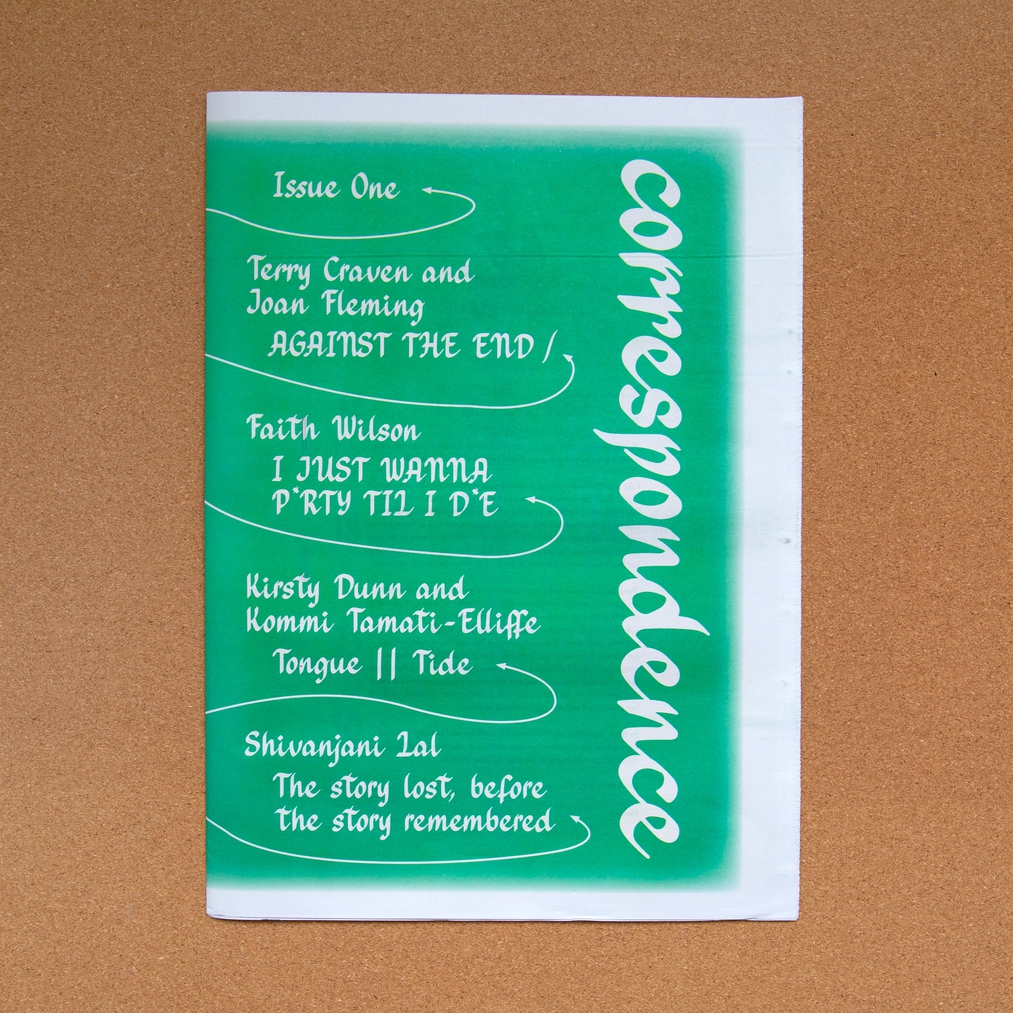
Correspondence 1.1 Cover, designed by Emma Kevern
To recognise the fundamental role of relationships in contemporary publishing and artistic practice, support them, and make them audible, we have developed a new serial publication: Correspondence.
This free, biannual serial will publish pairs of audio/text/page-works, which are initiated as a form of correspondence. These may be standalone works by individuals or collectives that call out across issues, or more direct collaborations and messages between one-another. Correspondence calls forth an abundance of voices; an unpredictable chorus.
This chorus should include readers of all bodily experiences. Our work with accessibility advocates and members of the blind and low vision community has developed into a set of guidelines for contributors to use when recording their contributions as part of each audiobook edition. Seeking greater connections between the work we publish and the communities we inhabit, we will continue to make audiobooks a core part of our publishing work.
Correspondence volume 1 will feature work by Kirsty Dunn, Kommi Tamati-Elliffe, Joan Fleming, Terry Craven, Shivanjani Lal, Sancintya Mohini Simpson, Faith Wilson, and essa may ranapiri. These relationships have produced a viscous material—of language and imagery—which forms issue 1 of this volume. The experiences of mass extinction, intergenerational migration, transcontinental genealogies, and reclaimed language offered by the contributors to this issue take to the page as, and in response to, their ongoing artistic practices. These same relationships will return to form issue 2.
Alongside the free print, audiobook, and PDF, editions of the publication, designer and developer Emma Kevern has been working with our website Designers, Sons & Co to develop an accessible audiobook and epublication platform, which has now been incorporated into this page. As well as this brief introduction, PDF downloads, and info on how to get a free print copy, you can now click the links on the contents list below to browse the full digital contributions to Correspondence 1.2.
Collectively, we hope the work of Correspondence will offer not only lively works to a wide readership, but also attend to the relational spaces that are vital to all of our work.
You can download the full Issue 1 for free as:
— An Audiobook narrated by the contributors
— A PDF edition of the printed publication
— A EPUB for screen-readers and mobile devices
Contents
- Editorial note
Hamish Petersen - AGAINST THE END /
By Terry Craven and Joan Fleming - The story lost, before the story remembered
By Shivanjani Lal - I JUST WANNA P*RTY TIL I D*E
By Faith Wilson - Tongue || Tide
By Kirsty Dunn and Kommi Tamati-Elliffe - About the contributors
- Colophon
Details
Correspondence Volume 1, Issue 1
- Publisheed November 2021
- ISSN 2744-7529 (Print)
- ISSN 2744-7537 (Online)
- ISSN 2744-7545 (Sound recording)
- Designed by Emma Kevern
- Printed by Allied Press, Ōtepoti
- Published by The Physics Room
- Ōtautahi, Aotearoa
- Featuring new audio/print comissions by: Terry Craven and Joan Fleming, Shivanjani Lal, Faith Wilson, Kirsty Dunn and Kommi Tamati-Elliffe
Downloads
Full PDF Download (PDF) AGAINST THE END / (PDF) I JUST WANNA P•RTY TILL I D•E (PDF) Tongue // Tide (PDF) The story lost, before the story remembered (PDF)Correspondence
Volume One, Issue One
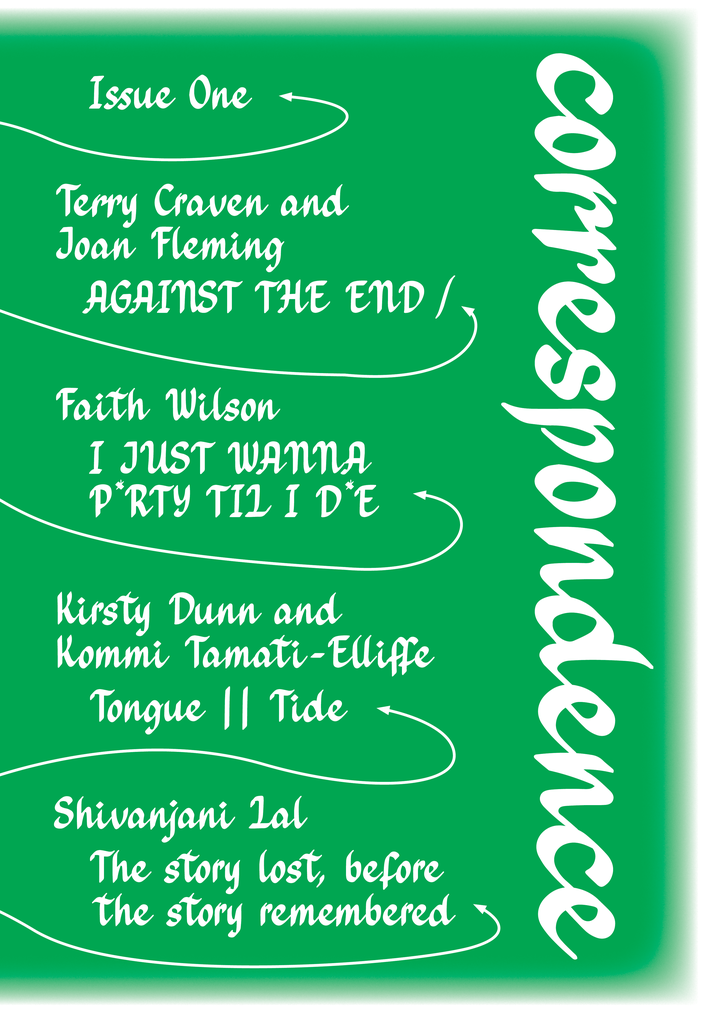
November 13, 2021
Tēnā tātou.
This is Correspondence; a place where the relationships that enable our creative labours and unevenly shared struggles are made legible.
Like a snail’s slimy trail, or kererū’s drunken slipstream, the cover design of this first issue renders the transits between the friends and mentors in this publication visible in print for a moment. The experiences of mass extinction, intergenerational migration, transcontinental genealogies, and reclaimed language shared by this volume’s contributors take to the page as, and in response to, their ongoing artistic practices. It reminds me how our lively bodies—and bodies of work—can never be cleanly separated.
The editorial model of Correspondence (inviting contributors to make work in correspondence with another contributor of their own choosing) prioritises the communities that artists work within, above the presumed authority of editors to determine who speaks on the pages we resource, and who reads them. These relationships become forces upon me and my labours. Like the Ngāi Tūāhuriri whenua that holds me, they are conditional offers I am called into reciprocity with. I take on the editorial task as one that implicates me and my porous Pākehā body in the work that appears here. So I keep an eye on myself; power no-longer invisible but enunciated and struggled with, on and on.
In these pages, the fugitive slime of knowledge and identity is shared, kept safe by the relations that have realised its viscous reality. These same relationships will return to the page to form Issue 2.
Until then, look after one another.
Hamish.
(Joan) Thank you for sending me the extinction lists.
[Terry] desert bettong : capricorn rabbit-rat : lesser stick-nest rat : broad-cheeked hopping mouse : nevis rice rat
(J) I find them unbearable.
...
(J) Hello how are you we are in the sixth mass extinction. We are the only species to be keeping scrupulous track of our own willing hurtle towards the end.
What does extinction require of us? You drop a black dot on a white page and try to feel the loss.
Reading gives the facts a home in the brain, but what about the body? What about the shadow? The shadow we are.
...
(J) It is impossible to be exact about the numbers.
...
“The darkness is greenish with creation and behaving like particles.”
[LK Holt]
...
(J) Last night, rats stripped the broad bean plants. Every leaf gone. They were already waist-high. This morning, as I sat on the back porch drinking feral tea and murmuring the name of my life, there was a moment when my vision caught. I couldn’t trust my eyes. Along the fence where there used to be green fruiting, there was now just a row of green spikes.
...
“What obligations do we have to hold open space in the world for other living beings?”
[Thom van Dooren]
...
[T] Black canvas. Starting point: writing/scrawling the names from the extinction lists.
Layers. A concrete covering/grave for them?
Perhaps. I am not yet sure whether the names will be legible. But perhaps I can print them out and have them alongside.
Yes.
...
(J) I want to be exact about the numbers. One site says 25 million native birds are killed every year by rats, possums, and stoats.
We say pest. Say pest and sneer. We don’t say who brought them.
...
(J) Dom handles the rat traps gingerly when he sets them, wearing gloves, and smearing peanut butter or ham onto the trigger plate. If they smell our human smell, they will avoid the traps. We have not caught any.
...
(J) Have you heard about the drowning hope experiment?
...
[T] If I were to draw this out as an infographic,
what would each point say of the endling?Only the way by which we can (mis)know it?
...
(J) Many historians have argued against the fact that the Dodo became extinct because she was delicious. Poor Dodo. She lived on fallen fruit. So easily captured or beaten with sticks.
The Dutch East India Company is still the largest megacorporation in human history. They dealt in silks, metals, porcelains, soybean, sugarcane, tea, livestock, and human slaves. Hungry sailors. They particularly savoured the Dodo’s stomach and breasts. The black rats— accidental on their ships—also predated on the Dodo, but humans were the apex predator. And we wrote about her. She was the first species whose extinction was conceded, in writing, to be caused by humans.
...
[T] guam reed-warbler : bermuda saw-whet owl : o’ahu ‘akialoa:
rodrigues blue-pigeon : rinsch’s duck
...
(J) Do you know what I mean when I say “thickening”? Is it possible to thicken a page with our not-knowing? Make texture from a loss that is impossible to conceive.
There is something I have been trying to say and I haven’t found a way to say it. I have wanted to write in order to take the fact of these extinctions into my body, because The Great Dithering—this historical moment we’re in—takes its power from its own abstraction. I have wanted to make it real, to take it into my body like a dark broth.
...
[T] Why watching a documentary like The Anthropocene was like watching science fiction.
Can we even understand now, in our bodies, this greater thing, the common?
...
(J) And I find I like all her names. Black rat, roof rat, ship rat, rattus rattus. (Thought loops, thought loops.)
It is possible she is not the monster.
...
[T] Layering black ink on black acrylic on black pastel and I had this strong impulse to add lighter tones, white smears, red names, brown names, green names.
Some “beautiful” trace.
With black on black might a viewer not ask:
Is there anything there at all?Am I not betraying something here?
...
(J) Dom has made a fresh drowning trap from a Coke bottle strung across the mouth of a bucket filled with water. The Coke bottle gets smeared with peanut butter and when Rat walks onto it, the Coke bottle spins, and she will not hold her balance. He found the instructions online.
...
“There are so many birds and most of them mean nothing…”
[Alice Oswald]
...
[T] White canvas. Starting point: The black dot.
Meditation on the extinct for each dot.
Finding the place in the body.
Building up. What feeling/s will emerge?
From the/se feeling/s what line/s?
...
(J) So this is what Catherine told me. A set of scientists discovered that rats could swim in water for eight minutes, and in the ninth minute, they drown. So the scientists put Rat into the water, let her swim to the edge of drowning, and before the ninth minute they took her out, dried her off, gave her food and water and rest, and then put her back in the bucket. They found that Rat would keep swimming right up to the edge of drowning, again and again she would swim valiantly into the ninth minute, and this was proof that Rat had hope.
...
“Adults keep saying we owe it to the young people—to give them hope—but I don’t want your hope. I don’t want you to be hopeful. I want you to panic.”
[Greta Thunberg]
...
(J) This morning the Coke bottle was muddy with prints and activity, but nothing was drowned. No-one was drowned. Rat might have left the peanut butter to Possum, who is too large to drown in a bucket.
Worlds are not containers. They are “risky co-makings, speculative fabulations.” [Donna Haraway] For some one surely, the empty bucket is a proof of hope.
...
(J) You know, I was shocked the first time I observed you licking Kitty’s head. Now I think about it all the time: that small gesture towards becoming animal, instead of reducing everything animal to a human mark. Black dot.
...
(J) In Aotearoa one often encounters the fact that possums have tuberculosis. It thickens our repulsion, because they strip the bush and blitz the nests and overreach their entanglement in every particular. It must soothe us to think that the possums are sick because they make the land sick. For us, they are dirt: in Lord Chesterfield’s definition, “matter out of place.” If we happen to touch an object a possum has touched, we sanitise our hands.
Here on Wurundjeri country, ringtailed possums are original. They run along the powerlines and leave pellets on our drying sheets. They take one bite out of every plum. The Melbourne Zoo wants to fence them out. They belong. They’re a problem. Psuedocheirus peregrinus: “sometimes confused with the Black Rat.”
...
(J) rattus rattus : generalist omnivore : complex pest : plague
reservoir : resilient disease vector : famous for the Justinian
Plague : typically builds a spherical nest : a sampler :
fine disperser of fungal spore.
In the carrier bag of her blood, the range of disorders she can distribute with no harm to herself is astounding.
...
[T] Binge on dots. Dissolve dot to tongue, dot. Fuck the existence of dot.
Make each endling a dot, dot, dot.
...
(J) If you had to say where power lives in your body, what would you say? Hands?Wrists? Head? Root?
If you had to say where craving lives—is it the same place?
In Nichiren Buddhist cosmology, the lower paths are hell, hunger, anger, and animality. Heaven is also on the lower path because rapture is passive. When I used to smoke, I would feel the craving in my wrists and in my jaw. My jaw is where I hold the power of a nightmare after waking.
...
[T] For me the fear retches up from my solar plexus
to the back of my throat.“Have you tried medication?”
I have been asked this so many times.
...
(J) In last night’s nightmare, the afterlife was a kind of purgatory where, in petty social groups, we played out our worst selves in circles. The only escape was Space. I could propel myself into the dust and yaw between the planets, and in the dream, there was nothing peaceful or connected about that. It was an active terror.
Dom’s determination to exterminate grows by the day. It feels fucked to be composing-with while not wanting to be living-with, as twisted as coddling the dog while feeding him pinkish strips of pig meat.
...
[T] Kick the anti-cockroach spray further under the desk, away from the guests.
...
(J) What can an egg or a fledgling do against Rat’s capacity?
Rat can go anywhere. She can climb trees.
Only three percent remains untouched.
Our species climbs every tree.
...
[T] I added too much paint here and now I can’t remove it. There was a time when, still drying, it would have been possible. Now I’m trying to pick it off. Cover it over.
The mark is so crude it’s painful to look at. I appreciate the irony: trying to feel extinction and getting hung up on a single painter’s mark. Hubris? Cognitive dissonance?
Underneath lie the erased names.
...
(J) I have always known my dominant lower path was hunger.
Endless craving.
Cheap nature is over.
...
[T] As I work I keep thinking, why are you averting your eyes from this?
What in this can be brought to joy?
Can happen? Can happen?
...
(J) Have you heard of this place, Rum Jungle? Australia’s first major uranium mine, on Malak Malak country. It supplied US and British nuclear weapons during the cold war. When the pyrite in the waste rock and tailings was exposed to air and water, it created radioactive material and acidic liquid waste that’s been leaching into the river beds since. People report seeing thick salt crusts made of heavy metals and radionuclides. Pools of water in rich red and aqua green. Nothing lives in that water. It was a Malak Malak woman who first showed a white prospector named Jack White the bright rocks that would bear uranium. 1949, and of course there were sacred sites nearby. I read that the punishment for the woman’s transgression against country was bodily, it was taken into her body. She contracted leprosy and spent her remaining years at the Channel Island leprosarium.
So Medean, no? The site is still considered culturally unsafe. Traditional Owners won’t go near it. A big king brown snake Dreaming is considered to have been
activated. Radionuclides as venom.
...
(J) I know we are instruments for catastrophe, but I’m asking about the body because I want to know how we can be instruments against catastrophe, and if we can, then perhaps there is a place in the body where the heat for that fight lives.
...
[T] This might be the most tiring painting project to date. If each time I place the black dot I take the loss of a species into the body, where I feel it is in the back of my throat. Sick. And fatigue. Wanting to switch off. Wanting to slip into sleep.
The names just keep piling up.
I read the reasons for extinction:
introduction of non-native species / pollution /annexing of water for use in agriculture.
I don’t want to continue.
...
(J) And if there is, should it be marked?
...
(J) Pitjantjatjara healer/artist Tinpulya Mervyn says that in the old days, wild cats used to attack and kill people. They were at their most dangerous during drought. Feral cats with poison spirits, killing adult humans when the country was sick. Do I believe her?
Do I believe her story of how the heat arrived in her hands?
Where has reason got us?
Obviously, the droughts are on their way.
We have armed the earth.
...
“There are so many birds and most of them mean nothing
but once or twice a gannet
from a nest of slovenly seaweed
hops
as far as those stones and stops”
[Alice Oswald]
...
(J) We’ve abandoned the drowning trap, baitless in the backyard. The plastic of the white bucket is so old, it crumbles when I kick it. (I don’t mean to.) Dom has cut away the ivy along the foot of the fence, to minimise habitat.
One of the bean plants Rat stripped to its stalks has sprouted a new head of leaves. There have arrived now more white blossoms.
[T] Would you believe me if I said that each dot was felt as an endling’s death?
Of course not.
Quotations are from:
LK Holt, Capacity; Thom van Dooren,
Flight Ways: Life and Loss at the Edge of Extinction; Alice Oswald, Nobody; Greta Thunberg at Davos in 2019; Donna Haraway, Staying with the Trouble: Making Kin in the Chthulucene. “The Great Dithering” is also Haraway’s phrase. The Rum Jungle story is from the AIATSIS publication, The Right to Protect Sites: Indigenous heritage management in the era of native title, edited by Pamela
Faye McGrath. Tinpulya Mervyn’s story
is from Traditional Healers of Central Australia: Ngangkari.
Back to contents
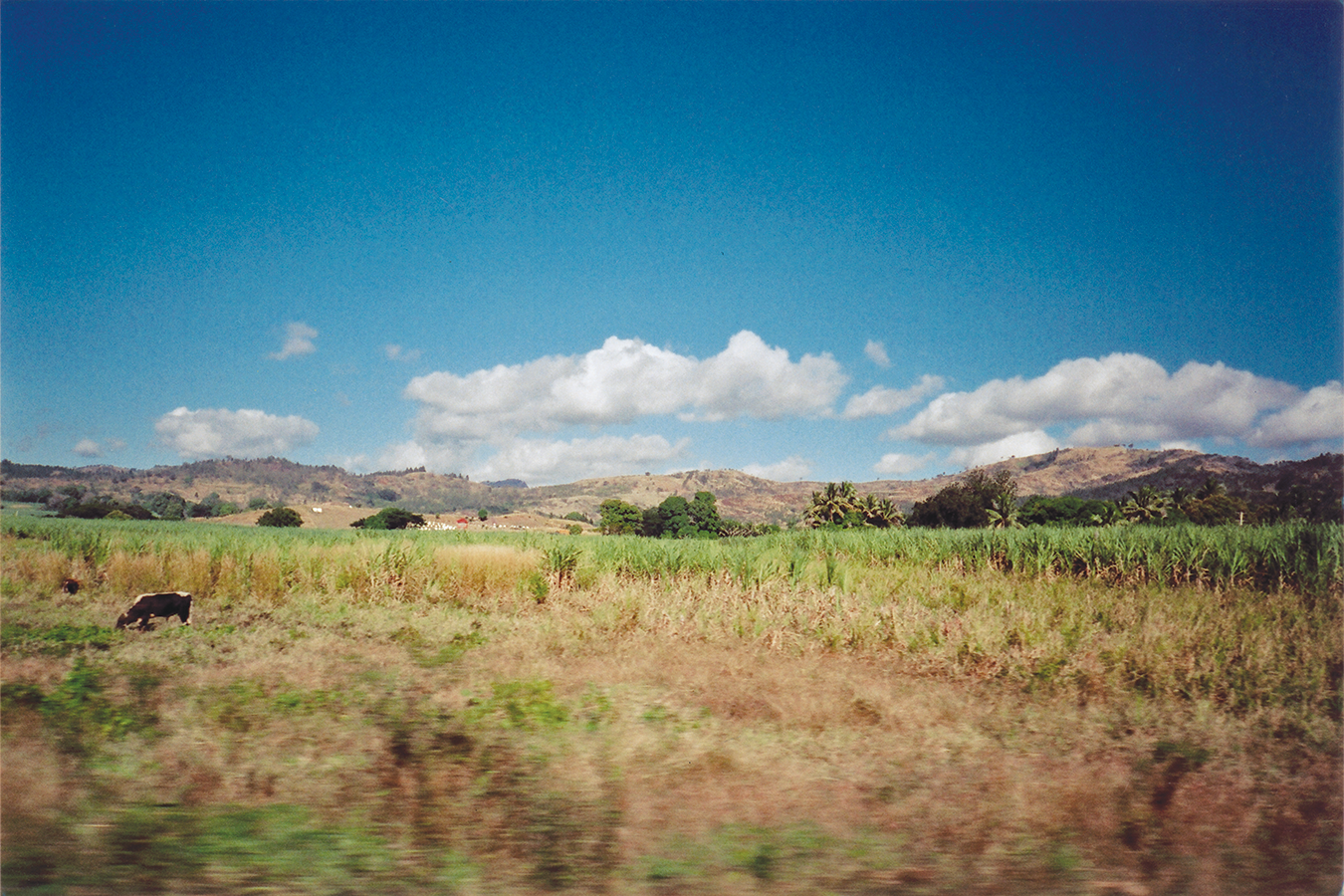
July 2019
A man hails the car my dad is driving on the way to Ba town.
He stops for him, and my maama climbs into the car and sits next to my aunt and mum. He needs a lift to FSC, it’s on the way so we’re happy to offer him a lift. He’s a cane worker. It feels important to listen to him as he speaks to my mum. He’s a living reminder of the girmit history and what he says resonates. He’s scared about the future, and knows his children don’t want to be cane workers. Why can’t they have the better life we were promised? He knows that there might not be anyone after him to take care of the land he tends. Aise aise hai, he says, this is how it is: the future feels unknown. It is destiny. His voice shakes but he insists on wanting to share chai with my mum. She says no, telling him that this fleeting moment of meeting was enough.
Was it though?
We leave him at FSC.
Across the road I see a globe being held in two hands with a magnifying lens over Fiji. A sign underneath says Sugar for the World.
Sunshine hits my skin and we drive on.
* * *
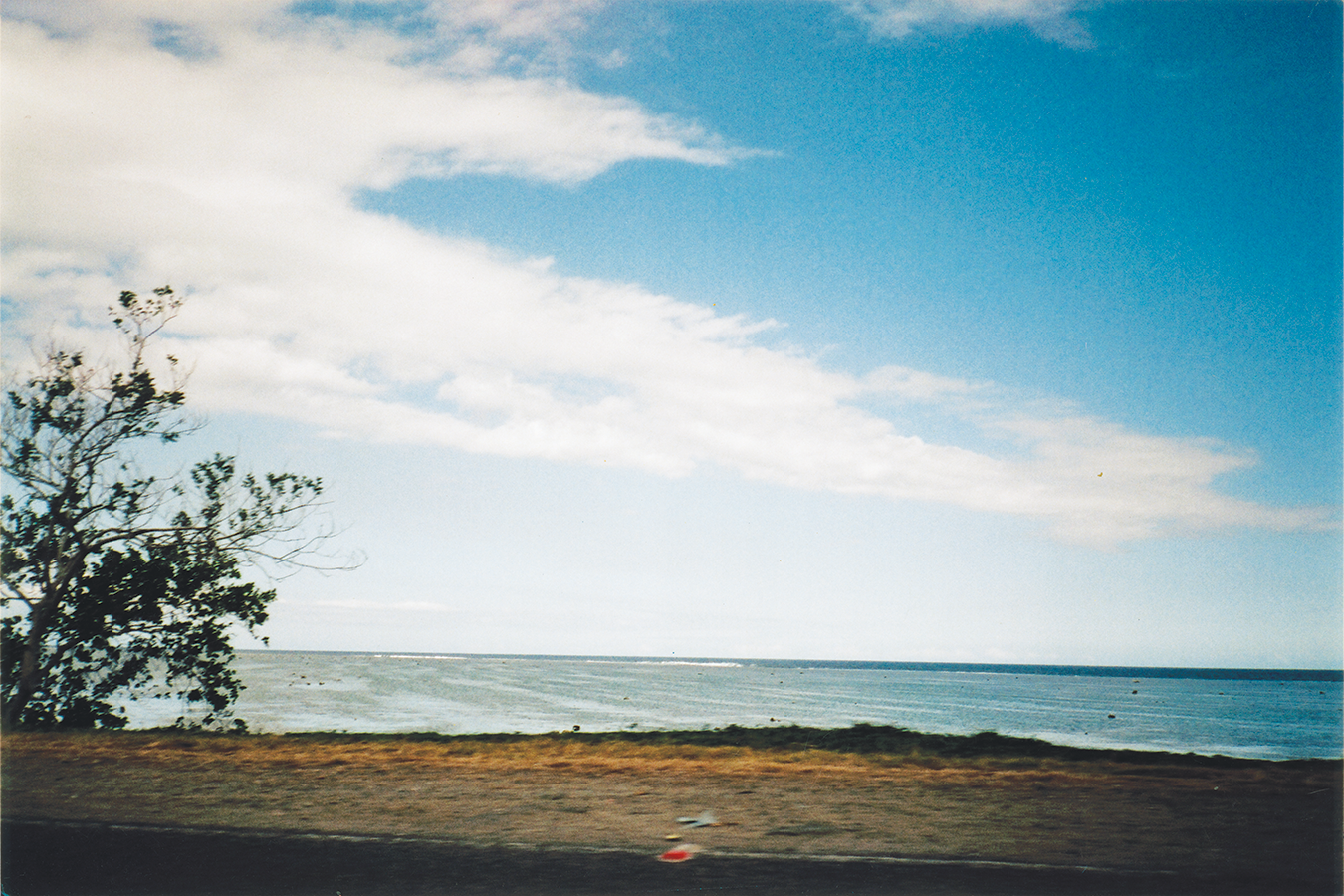
A nadi, a river
An echo; a mirror
A reminder, a memorial, a longing for home
On the wrong island, the wrong river
I sing out this prayer
No flowers, just stones, just bones
* * *
They had birds and fishes under their skin
Papery and translucent, as though they would disappear when they slept at night
Disappearing into their blood only to return in the morning
I used to trace the lines of initials and flowers
Wondering how they got etched onto my grandmothers’ bodies
It was a comfort to see marks so lived in
I imagine dark nights and laughter ringing out as their marks were made
Imperfect and fragile
When I touched them I felt whole histories
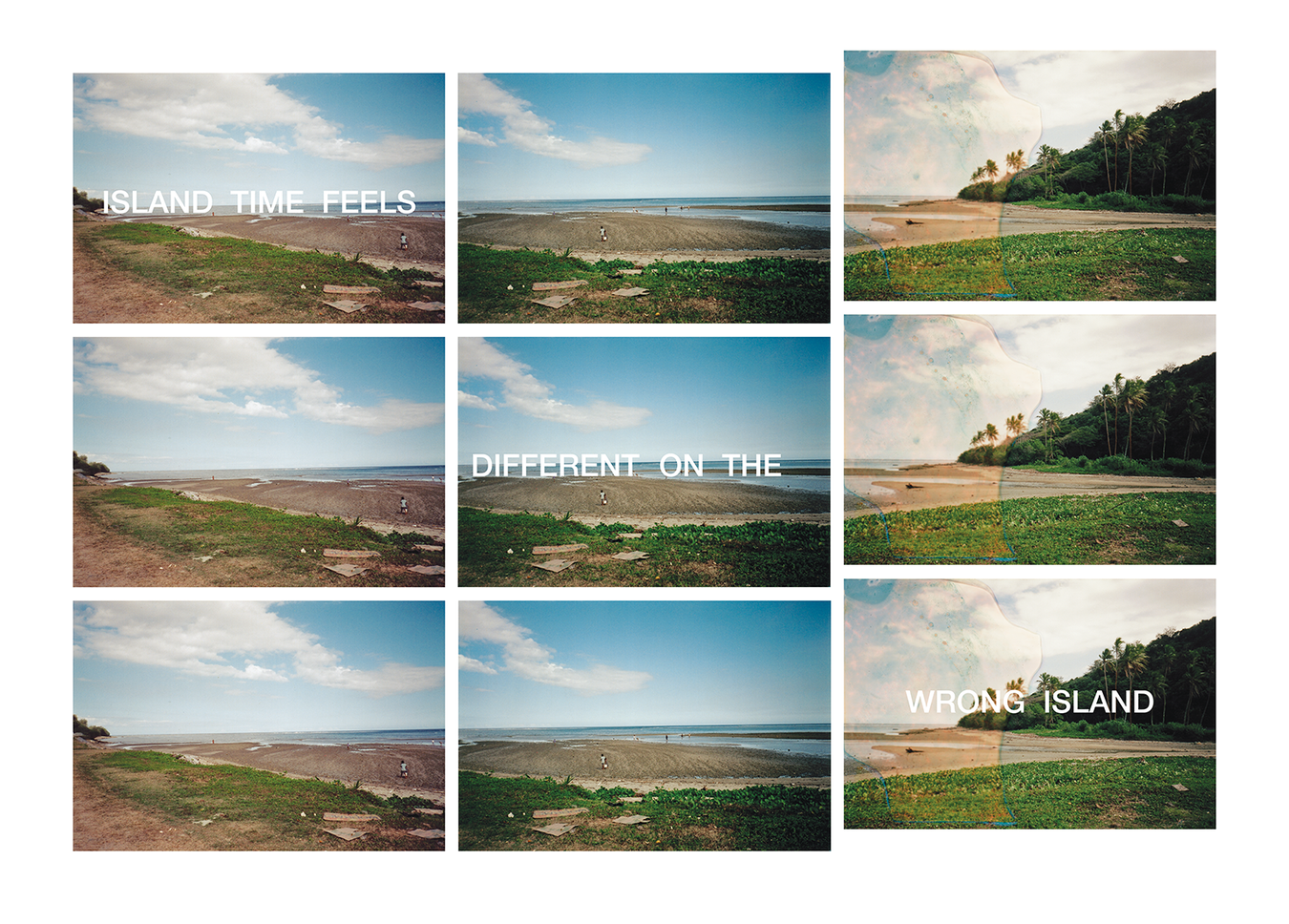
I partied so hard my toenails fell off
I partied so hard my toenails fell off. My body is a shell and my cells generate new cells to replace the dead things. I drank myself into a stupor. I became one with the earth’s beat. I spewed up eels and rainbows and guns. I spewed up coconuts and taro leaves and strange names and I spewed up hair and nifo that I ate off the root of a plant. I bound my feet with taro leaves and walked back through the tracks of my ancestors. I trudged through the mud I wiped the mud on my face. I slipped and I fell and I ate dirt I ate earth. Tired yet still I walked. Tired I ate tuna from the river I ate coconuts from the tuna’s head. I reached the shore and I reached the ship and I drank juniper gin and I lost my head. I leaned overboard and I looked at my reflection on the water and I saw my father’s face and my mother’s face and I couldn’t see myself. I danced to the beat I danced to the ocean beat I danced to the beat of my blood. I danced and I ate roasted boar and I bled ancient DNA into their gin and their wine and it tasted like nectar and
it acted like poison and we danced til we fell and their heads fell off and I was the only one dancing, the only one still on my feet, my feet bound in taro leaves, I pushed their bodies onto a pyre I burnt the pyre I danced around the pyre I ate their flesh I ate them my ancestors I ate them and I danced and I danced until the taro leaves came off and my feet were bloody and my toenails fell off and I fell and I slept near the pile of burnt bones. I shat out the bloody histories of my colonising forefathers and foremothers and I smelled it and it smelled bad and I’ll never get that shit-stench out of my head. I remember it with every step I take on this vibrating fanua on this land I now call home on this land that has housed me and accepted me and whose beat I have synced with. I walk with the stench emanating, and I walk with gratitude and a head hung in shame. I get used to the stench I live with the stench I am at peace with the stench I use the stench to write a new story The story is about how I walk between worlds and how I walk between my histories and the footprints I leave become legend. This is a story about how life becomes myth.
DNA tests-rahui-ancestry-desuetude-don’t pick up that phone
Everyone takes a DNA test to discover whether their blood is more exotic
than it really is. We’re all just flesh on bones. We’re all just vibrating cells.
The heart of the universe is a steady, insistent beat: the sound of cycles in sync.
A quote from Steven Strogatz’s book about vibration: Sync: How Order Emerges from Chaos in the Universe, Nature and Daily Life. I was interested in the idea of there being a heart of the universe, and that it provides a beat, a music that we unconsciously live by.
You can still be romantic about your lineage. Descended from Paramount Chiefs in Vaimoso, Siumu, Fasito’otai. Descended from the Chiefs of Clan Gunn. We’re all vibrating cells, we all have our own beat. We’re all flesh on bones.
Aut pax aut bellum | Either peace or war.
This is the official Clan Gunn motto. I was so struck by the savagery of it.
Gunn means war in old Norse. Clan Gunn is one of the oldest Scottish clans, descended from Norse Vikings, thirsty for blood and a reputation for fighting.
Either peace or war ... don’t fuck with me or I’ll kill you. We’re all vibrating. Mitochondrial Eve, wrap me in your arms ... We’re flesh and bones. We’re each a chapter in the myth of our gafa. Inheriting stories, tall tales, and then we write our own. What stories will you pass on, and which will you take to the grave?
If you want to find the secrets of the universe,
think in terms of energy, frequency and vibration.Apparently, a quote from Nikola Tesla, but I don’t know where/when he said it. I just iked the way it sounds.
This rāhui is making me pissed off. My phone vibrates with the energy of a thousand managers asking me if I’ve seen that email followed up on that meeting updated that document and that, my friends, is called frequency.
Don’t you dare touch that phone!
A hilarious song with a funky beat. IYKYK.
Descended from gods. I took comfort in the bosom of my mother’s stories I suppose that the earliest memories of most of us concern our mothers.
This is a line from a book My First Eighty Years, written by a relative on my father’s side, Helen Wilson. I grew up actually thinking she was my great, great grandmother or something but found out recently she was an aunt or second cousin. The book is boring as hell, but is an account of early colonial life here in Aotearoa, particularly their settling down south.
But I want to write a story about my fathers, all of them I resisted them. Do I start in the highlands of Caithness? Or with the street rats of Bermondsey? Do I start as their ship arrived on the shores of Aotearoa? Where one story ended another myth began writing itself. How they fought in the highlands and built castles out of bones. How the stories they told were passed down. What histories do I call upon and what has been omitted? What is pure bull shit and what of those stories still live in me? What are the stories I carry like lead in my veins? Am I stuck with them or can I rewrite them like you straighten the crooked teeth from your dad’s side? Can you purge and shit the stories out like a good liver cleanse? What if you don’t like what you see and worse yet ... what if you are unmoved by it? What if you dive down through the wreckage and you emerge to the surface with nothing? I can only start with what I know. Let me write you a story.
PLEASE DO NOT EDIT THE SEPT LIST, Daddy
This comes from a note at the bottom of the “Clan Gunn” Wikipedia page. It made me laugh that someone would write a note in all capitals telling someone not to edit the sept list. A sept is a family branch/clan.
this is my daughter she is yours too she is where the seas meet the tidal race she is woven from ancient tongues and brackish water and laumei and jellyfish and tuna and tartan and gunsmoke and swords and mud. she is not yours to sacrifice she belongs to the sea and she will bring peace and she will also bring war and she will return to this point when she is old and greying and she will weep for her forefathers and her foremothers and she will weep for her children lost to the sea lost to the sea lost to the sea so raise her to know the taste of salt in her bones. to know the sharp smell when blood mixes with seawater. raise her to walk between worlds harden the soles of her feet. to write stories from seafoam and equally to forget them.
For thirty years I wrote my own myths and for the last year I burned them. Some of us lost our tongues and some of us had them cut out.
In Caithness and Sutherland you roamed for thirty years, poor and white
A line from Sylvia Plath’s poem “Daddy.”
starting fights with Clan Keith. And then you had me but I was a wild thing with bones in her hair a wild thing with savage tendencies with savage thoughts and a taste for blood and you realised we’re not so different. Either peace, or war. You held me as a pepe by the feet and you stood at the edge of the cliff. Here, take this wild young thing take this dark, wild thing and i’ll never fight again. And the sea rose to meet you and Tagaloa’s voice rang back.
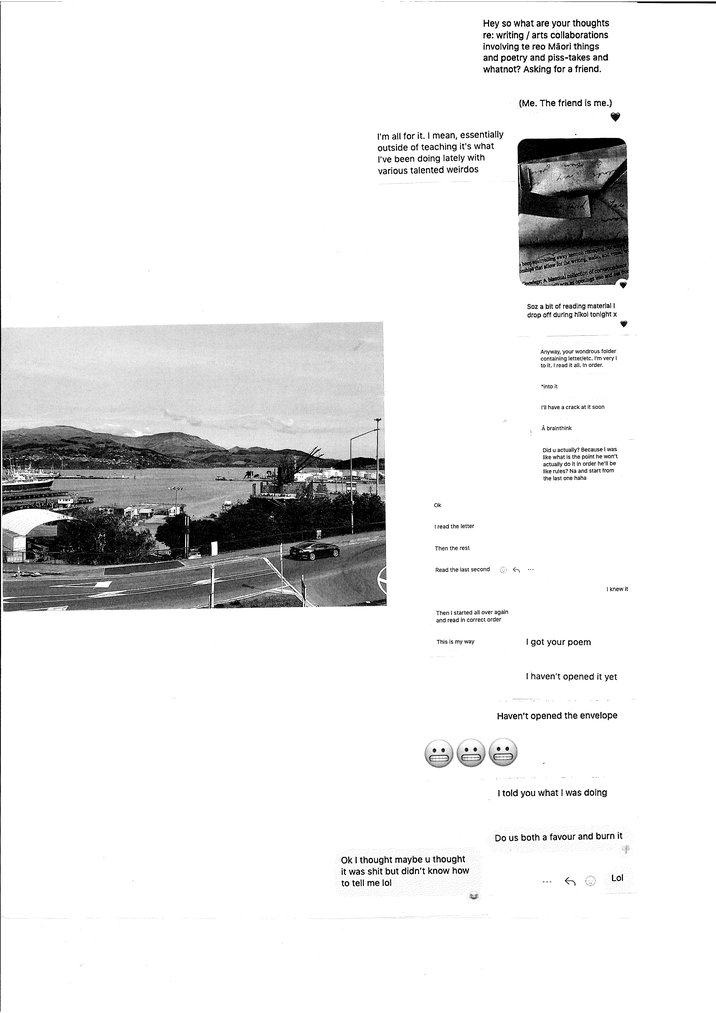
Tongue || Tied
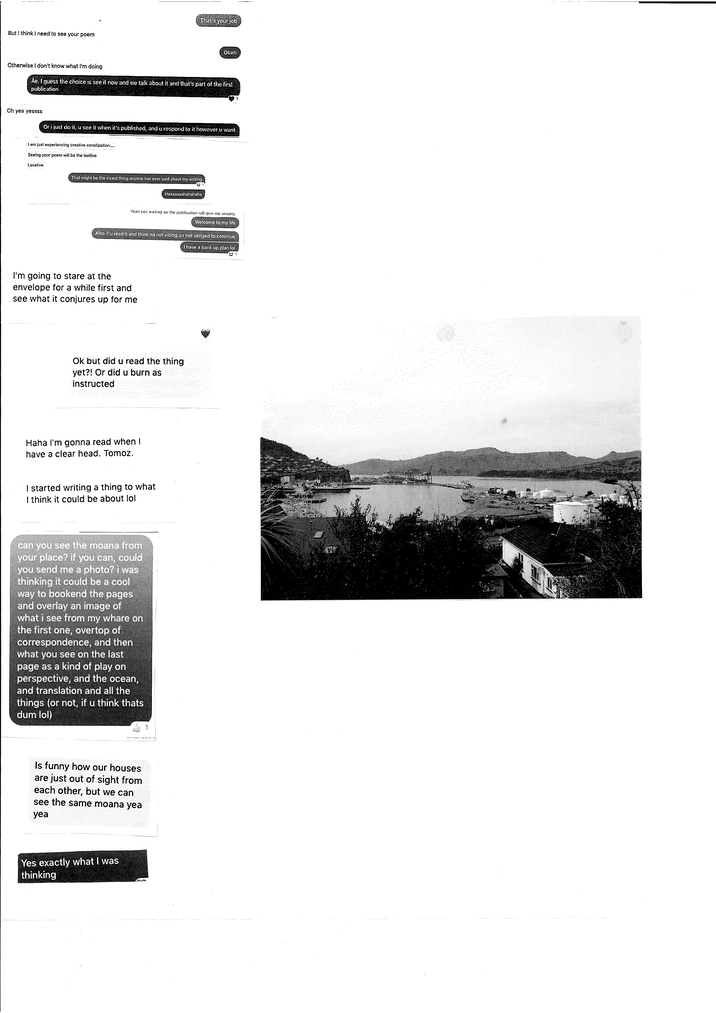
Terry Craven is a painter and co-owner of Desperate Literature, Madrid. He is represented by Arniches 26 Gallery and his writing has appeared in 3:AM and
The London Magazine.
Joan Fleming’s latest book is Song of Less (Cordite Books), a verse novel exploring ritual, taboo, and the limits of individualism in the ruins of ecological collapse.
Terry and Joan will continue their correspondence in Issue 2.
Shivanjani Lal is a Fijian-Australian artist. Her work uses personal grief to account for ancestral loss. She explores narratives of indenture and migratory histories from the Indian and Pacific oceans.
Shivanjani is corresponding with Sancintya Mohini Simpson, who will contribute to Issue 2.
Faith Wilson (Sāmoa, Germany | Clan Gunn, England), is a writer and editor living in Tāmaki Makaurau. She is the founder of Saufo`i Press, a staff writer at The Pantograph Punch, and has published work in many local and international publications.
Faith is corresponding with essa may ranapiri, who will contribute to Issue 2.
Kirsty Dunn (Te Aupōuri, Te Rarawa, Ngāpuhi) is a writer, researcher, and māmā based in Ōhinehou. She recently completed her PhD in Māori Literature in English at the University of Canterbury.
Kommi Tamati-Elliffe (Kāi Tahu/Te-Āti-Awa) is a propagator of te reo Māori. A musician/rapper and lecturer in Māori and Indigenous Studies who teaches reo throughout the community with regular collaborations with Kāi Tahu artist Turumeke Harrington, Kāi Tahu artist/writer Kiri Jarden, and Kāi Tahu/Ngāi Tai musician Marlon Williams.
Kirsty and Kommi will continue their correspondence in Issue 2.
Emma Kevern is a graphic designer based in Ōtautahi. Her recent work has included exhibition poster design for Hot Lunch and website design for local artists.
Correspondence
Volume 1, Issue 1
November 2021
ISSN 2744-7529 (Print)
ISSN 2744-7537 (Online)
ISSN 2744-7545 (Sound recording)
Designed by Emma Kevern
Printed by Allied Press, Ōtepoti
Published by The Physics Room
Ōtautahi, Aotearoa
The Physics Room works within the takiwā of Ngāi Tūāhuriri
Correspondence publishes pairs of works for the page and ear as openings into and through artistic practices and relationships. You can also access Correspondence as an audiobook edition and screen-reader friendly EPUB/PDF for download at www.physicsroom.org.nz/publications.
Correspondence is edited by Hamish Petersen, with assistance from Abby Cunnane and Michelle Wang, and supported by the whole Physics Room staff: Audrey Baldwin, Orissa Keane, and Keren Oertly Ryan. To contact the editors, write to hamish@physicsroom.org.nz, or call the office at +64 3 379 5583.
Thank you to all of the contributors to and collaborators on Correspondence 1.1, and to Emma Kevern and Matt at Sons & Co for their caring development of an online platform for Correspondence, forthcoming with the release of Issue 2, completing our first volume in May 2022.
The Physics Room is a contemporary art space dedicated to developing and promoting contemporary art and critical discourse in Aotearoa New Zealand. The Physics Room is a charitable trust governed by a Board of Trustees.
© The Physics Room, 2021
This work is licensed under a Creative Commons Attribution-ShareAlike 4.0 International License. To view a copy of this license, visit http://creativecommons.org/licenses.by-sa/4.0/. Images are exempt and are copyright of the authors.
